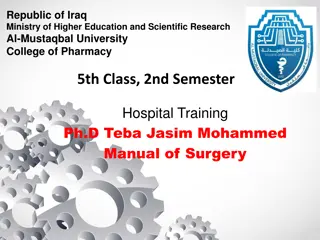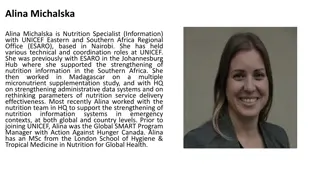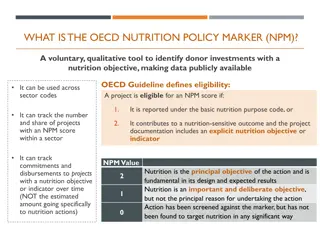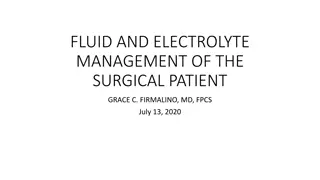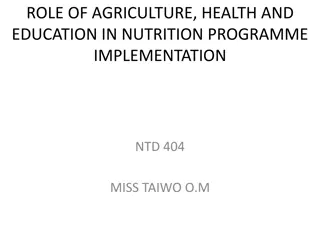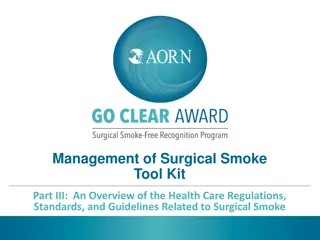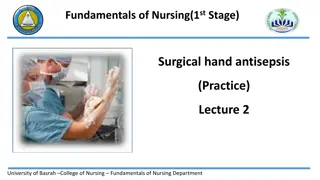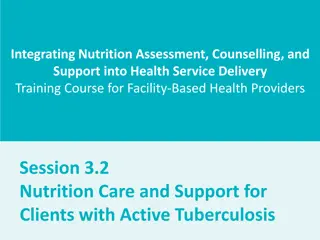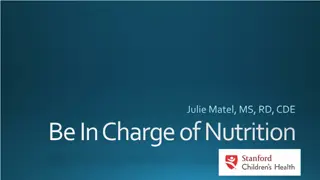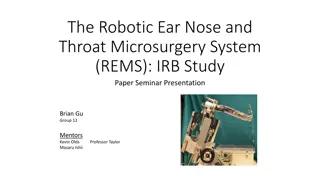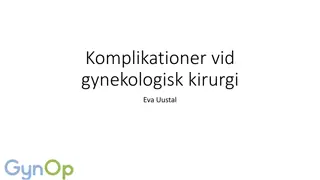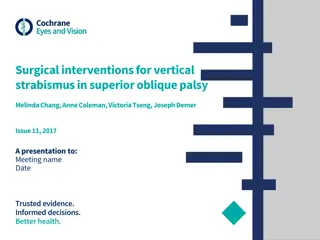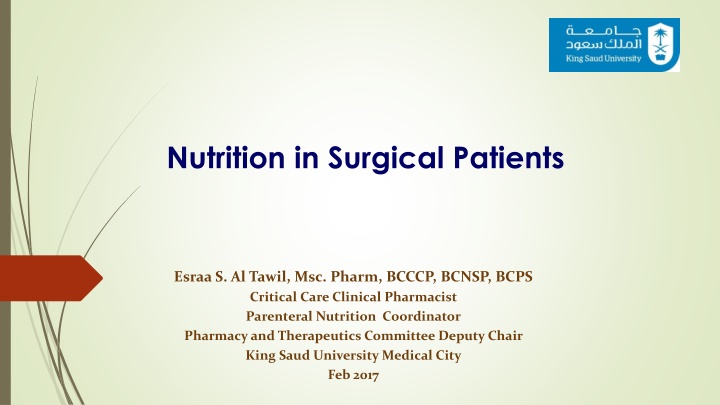
Nutrition Assessment in Surgical Patients - Key Points to Consider
Understand the importance of nutrition assessment in surgical patients to prevent complications and support healing. Discover classic definitions of malnutrition, weight loss criteria, and serum proteins utilized in nutritional assessment.
Download Presentation

Please find below an Image/Link to download the presentation.
The content on the website is provided AS IS for your information and personal use only. It may not be sold, licensed, or shared on other websites without obtaining consent from the author. If you encounter any issues during the download, it is possible that the publisher has removed the file from their server.
You are allowed to download the files provided on this website for personal or commercial use, subject to the condition that they are used lawfully. All files are the property of their respective owners.
The content on the website is provided AS IS for your information and personal use only. It may not be sold, licensed, or shared on other websites without obtaining consent from the author.
E N D
Presentation Transcript
Nutrition in Surgical Patients Esraa S. Al Tawil, Msc. Pharm, BCCCP, BCNSP, BCPS Critical Care Clinical Pharmacist Parenteral Nutrition Coordinator Pharmacy and Therapeutics Committee Deputy Chair King Saud University Medical City Feb 2017
Introduction Surgery is the cause of a number of deep inflammatory and metabolic changes The primary objective of ensuring the adequate defense of the body Malnutrition is associated with changes in body composition, and delayed wound healing, decreased functional capacity, impaired immune function and changes in the different organ systems Therefore, malnourished patients are at risk of experiencing infectious and cardiorespiratory complications, increased morbidity and mortality and prolongation of hospital stay. However, it has been shown that early post operative enteral nutrition is effective and well tolerated Enteral feeding is associated with clinical benefits, such as the reduction in the incidence of postoperative infectious complications and improved healing of tissues. Therefore, the nutritional intervention is essential as part of the treatment of postoperative gastrointestinal patients, including those with good previous nutritional status, since the worsening of nutritional status due to the surgical stress and critical illness will be a determinant factor of poor subsequent outcome.
Nutrition Assessment Malnutrition: Classic definition Marasmus (e.g., decreased fat/muscle protein stores but normal serum proteins) Kwashiorkor (e.g., normal fat, decreased muscle protein, decreased serum proteins) Kwashiorkor-Marasmus mix (decreased fat, muscle protein, and serum proteins)
Nutrition Assessment Based on weight loss A 10% unintentional weight loss within a 6-month period is considered significant. Based on current weight Mild malnutrition: 80% 89% ideal body weight (IBW)* Moderate malnutrition: 70% 79% IBW* Severe malnutrition: Less than 70% IBW* Obese: Greater than 130% IBW* Based on body mass index (BMI) = weight (kg)/height2 (m2) Less than 18.5: Underweight 18.5 24.9: Normal 25 29.9: Overweight 30 34.9: Class I obesity *IBW: Female = 45.5 kg/5 ft plus 2.3 kg per inch above 5 ft Male = 50 kg/5 ft plus 2.3 kg per inch above 5 ft 35 39.9: Class II obesity Greater than 40: Class III obesity
Nutrition Assessment Serum proteins used in nutritional assessment Albumin: Half-life 20 days Depletion: Mild 2.8 3.5 g/dL, moderate 2.1 2.7 g/dL, severe less than 2.1 g/dL Limitations: Long half-life, large body pool; is a negative acute-phase reactant protein that decreases in response to infection, inflammation, surgery, injury, or other acute event Transferrin: Half-life 7 days Depletion: Mild 150 250 mg/dL, moderate 100 150 mg/dL, severe less than 100 mg/dL Limitations: Increased with iron deficiency; is a negative acute-phase reactant protein that decreases in response to infection inflammation, surgery, injury or other acute event Prealbumin: Half-life 2 days Depletion: Mild 10 15 mg/dL, moderate 7 10 mg/dL, severe less than 7 mg/dL Limitations: Increased with CKD; is a negative acute-phase protein that decreases in response to infection, inflammation, surgery, injury, or other acute event
Nutrition Assessment Physical examination: Loss of subcutaneous body fat, muscle atrophy (including temporal wasting), presence of lower extremity edema and/or ascites Subjective Global Assessment (JPEN J Parenter Enteral Nutr 1987;11:8-13): Incorporates overall evaluation by incorporating five elements of the patient s history (presence of weight loss, dietary intake change, presence of significant adverse GI symptoms persistent for more than 2 weeks, physical functional capacity, and metabolic demands of the patient s disease state) and physical examination
Energy Requirements Assessing caloric requirements: Indirect calorimetry Measured energy expenditure by oxygen consumption and CO2 production The gold standard Respiratory quotient (Vco2/Vo2); 1 for carbohydrate oxidation; 0.7 for fat oxidation; 0.8 for protein oxidation; greater than 1 usually implies overfeeding (net fat synthesis), less than 0.7 suggests ketosis or an error in measurement (too much fraction of inspired oxygen [Fio2] variability at higher Fio2 concentrations) Organization guideline recommendations Next slide Many equations: beyond the scope of our lecture
Adverse effects of overfeeding Do not exceed 5 mg/kg/minute of glucose/carbohydrate (Ann Surg 1979;190:274-85) Limit total caloric intake Do not exceed intravenous fat intake of 2.5 g/kg/day (most clinicians limit intravenous fat to around 1.5 g/kg/day or less).
Adverse effects of overfeeding Hypercapnia: It was traditionally thought that excessive glucose intake alone was responsible for hypercapnia observed during overfeeding. However, studies of acutely ill patients showed that aggressive feeding resulted in marked increases in CO2 production (Ann Surg 1980;191:40-6; JAMA 1980;243:1444-7). Substitution of glucose kilocalories with lipid decreases CO2 production (Anesthesiology 1981;54:373-7) when overfeeding but does not alter CO2 production if not overfeeding (e.g., 1.3 x BEE) (Chest 1992;102:551-5). Because most institutions lack the ability to measure energy expenditure, estimates are used. If the patient experiences hypercapnia without a known cause, the nutrition therapy should be suspected and the caloric intake empirically decreased (especially if the patient is having trouble weaning from the ventilator).
Adverse effects of overfeeding Hyperglycemia: In a retrospective study of 102 PN-fed patients not predisposed to hyperglycemia, dextrose intakes in excess of 5 mg/kg/minute resulted in substantial hyperglycemia (blood glucose [BG] greater than 200 mg/dL) in 18 of 37 patients (Nutr Clin Pract 1996;11:151-6). Patients with stress-induced hyperglycemia or diabetes are even more susceptible to hyperglycemia with EN or PN.
Adverse effects of overfeeding Fatty infiltration of the liver: May be owing to overfeeding with fat or carbohydrate. Usually presents as a cholestatic liver disease (increased -glutamyltransferase, alkaline phosphatase, and ultimately bilirubin) after at least 1 week to 10 days of overfeeding (Arch Surg 1978;113:504-8). May be transient or reversible or can progress to end-stage liver disease. Over a few weeks, patients can appear jaundiced. Patients with critical illness and/ or infections tend to be more susceptible to hepatic steatosis compared with non critically ill patients (possibly because of an exaggerated inflammatory process). Although treatment with fish oil appears promising in infants and children (Ann Surg 2009;250:395-402; Nutr Clin Pract 2013;28:30-9), data for adults are lacking. Usual management for adult patients with suspected PN-associated liver disease is first to ensure the patient is not being overfed and given a mixed-fuel PN solution, followed by cyclic PN (PN is infused over part of the day). Reinstitution of EN as soon as possible (if possible) is of utmost importance.
Recommendations for caloric requirements Maintenance OR elective surgery: 25 kcal/kg/day Malnourished, nutritionally depleted: 1.4 1.5 x BEE Medical ICU patients: 25 30 kcal/kg/day Minor infection or surgery: 25 30 kcal/kg/day Major surgery/trauma/sepsis: 30 32 kcal/kg/day Obese (hypocaloric) nutrition: 22 25 kcal/kg IBW/day or less Older (older than 65 years): 1.3 1.5 x BEE Smaller patients (weight 50 kg or less): 1.3 1.5 x BEE *These are general recommendations, based on the lack of measured energy expenditure, from this author s practice, which are subject to exception depending on prevailing disease states, organ failures, extent of malnourishment, provision of paralytic drugs/pentobarbital/propofol, and types of injuries.
Indications for EN If the patient is unable to eat adequate amounts to achieve goal nutritional intakes. EN is preferred to PN because EN has less infectious complications (Ann Surg 1992;215:503-13; JPEN J Parenter Enteral Nutr 2009;33:277-316). This position is universally accepted among all guideline sources. Lack of bowel sounds, flatus, or bowel movement is not a contraindication for EN because these are non-specific indicators of GI function (SCCM/ASPEN 2009; (JPEN J Parenter Enteral Nutr 2009;33:277-316). Evidence of ileus (e.g., dilated loops of bowel on abdominal radiography) is, however, a contraindication for EN.
Indications for EN High NG output (greater than around 800 mL NG output) in a 24-hour period might indicate delayed gastric emptying, and the patient might not be ready for EN when fed into the stomach and post-pyloric feeding is not possible. If the patient s GI function appears to be improving, clamp NG tube for 4 hours and check GRV (if GRV is less than around 250 mL and the abdomen is not distended, patient is probably ready for gastric feeding). Refusal to eat/anorexia is not an absolute contraindication for EN. Ensure appropriate dietary preferences, and add high-calorie/protein liquid supplements to meals and bedtime snack first.
EN formulas FYI
Remember The rule of thumb If the Gut Works, Use It If the Gut Works Partially, Use It Partially
Indications for PN Patients who are not expected to receive EN within 3 days should receive PN within 24 48 hours if EN is contraindicated or if they cannot tolerate EN. European Society for Clinical Nutrition and Metabolism (ESPEN) PN guidelines (2009)
Indications for PN- Examples Short bowel syndrome Non-operative mechanical bowel obstruction High output gastrointestinal fistula Sever paralytic ileus Pseudo GI obstruction Gut ischemia Refractory diarrhea or vomiting Intolerance to enteral feeding If the energy and nutritional requirements cannot be met after maximizing enteral support Failure to Thrive
Criteria for Starting PN Expected Duration of PN therapy greater than 7 days. Venous access available Hemodynamically stable patient
Types of PN CPN vs. PPN (based on IV access type) 2 in 1 or 3 in 1 (based on admixture type) ASPEN Board of Directors & Standard Committee, NCP, 20:281-285, April 2005
Composition of PN PN = IV Food Micronutrients Macronutrients Electrolytes Trace elements Vitamins Amino Acid Dextrose Fat Other additives Ranitidine Heparin Water $150
Central Vs. Peripheral PN Peripheral Parenteral Nutrition (PPN) Central Parenteral Nutrition (CPN) Short duration (< 2 weeks) Long term PN (Indefinite duration) Maximum Osmolarity: 900 mOsm/L No limitation in the term of osmolarity Higher dextrose and amino acids concentrations Maximum concentrations: Dextrose: 10-12.5% Amino Acids: 2.5% Limitations: Limited calories and electrolytes Risk of extravasation &Thrombophlebitis Short period of time Need large volume of fluids Limitations: More expensive More risk of: Central line infection & sepsis mechanical and catheter related complications: (Pneumothorax, hemothorax , chylothorax, arterial injury, catheter embolism) metabolic complications: (hyperglycemia, acid base imbalances, electrolyte imbalances)
Osmolarity of PN Very important to be calculated especially in case if PPN. It should be < 900 mOsm/L if PPN (Adult) Pediatric patients can tolerate slightly higher osmolarity because of the increased elasticity of their veins up to 1000 mOsm/L Neonates may tolerate up to 1100 mOsm/L
Glucose requirements Obligatory requirements for central nervous system, renal medulla, bone marrow, leukocytes, etc.: Around 130 g/day Surgical wound about 80 150 g/day (based on atrioventricular differences and blood flow from a burned limb) Caloric contribution of glucose: 3.4 kcal/g Mean glucose oxidation rate in critically ill patients is around 5 mg/kg/min. In general, most clinicians avoid exceeding this glucose intake.
Protein Requirements Maintenance or elective surgery: 0.8 1 g/kg/day Minor infection or surgery: 1.2 1.5 g/kg/day Malnourished, nutritionally depleted: 1.5 g/kg/day Medical ICU patients: 1.5 2 g/kg/day Major surgery/trauma/sepsis: 2 2.5 g/kg/day Renal failure AKI: 0.6 1 g/kg/day CKD: 0.6 1 g/kg/day Hemodialysis: 1 1.5 g/kg/day CRRT: 2 2.5 g/kg/day Obese, hypocaloric BMI less than 40: 2 g/kg IBW/day BMI of 40 or greater: 2.5 g/kg IBW/day
Assessing protein requirements: Nitrogen Balance NB = nitrogen in (Nin) nitrogen out (Nout) To calculate Nin: Add all daily protein intake sources together, including the protein in EN, liquid protein supplements, oral dietary supplements, and/or PN solution. Convert protein intake (grams per day) to nitrogen intake (grams per day): Nin (g/day) = protein (g/day)/6.25 To calculate Nout: Nout (g/day) = (UUN + 4 g)* UUN is 24-hour urine urea nitrogen excretion (grams per day). Calculate the NB: NB (g/day) = Nin g/day Nout g/day. Measured versus predicted creatinine clearance (for gross assessment of adequacy in the 24-hour urine collection) Serum prealbumin changes are unreliable because of the influence of stress/inflammation; some clinicians will obtain a serum C-reactive protein concentration together with a serum prealbumin concentration for assessment. Nutrition 2005;21:332-8
Does more protein really make a difference? Weijs (2012) (JPEN J Parenter Enteral Nutr 2012;36:60-8): 28-day mortality improved in those who received an average of 1.3 g/kg/day versus 1.1 or 0.8 g/kg/day (886 mixed ICU patients). Allingstrup (2012) (Clin Nutr 2012;31:462-8): 28-day mortality improved in those who received an average of 1.5 g/kg/day versus 1.1 or 0.8 g/kg/day (113 mixed ICU patients).
Glutamine The patients where elective abdominal surgery is indicated show some degree of malnutrition and a deficit of circulating glutamine for different reasons: Anorexia intestinal obstruction blood loss, etc. This situation worsens postoperatively, since glutamine demands increases in response to the aggression, having demonstrated that circulating and muscle-released glutamine values are inadequate for surgery stress
Glutamine contd A metaanalysis including 9 randomized, controlled clinical trials, with a total of 373 patients undergoing abdominal surgery, concluded that administration of PN supplemented with glutamine (20-40 g/day) has a beneficial effect on nitrogen balance, reduces hospital length of stay and infectious complications (Ia). World J Gastroenterol 2006; 12:7537-41. Dechelotte conducted a multicenter, randomized, double- blind, controlled study, with administration of PN supplemented with glutamine versus PN without glutamine, concluding that in the glutamine group infectious complications are reduced and a better glycemic control is achieved(Ib). Crit Care Med 2006; 34: 598-604. Oguz conducted a study in postoperative patients with colorectal cancer, where enteral nutrition vs enteral nutrition supplemented with parenteral glutamine was administered, in a total of 109 patients, concluding that glutamine supplements reduce the number of postoperative complications and hospital stay (Ib). Colorectal Dis 2007; 9: 515-20.
Glutamine contd The A.S.P.E.N. Position Paper 2011 a comprehensive review of 10 meta-analyses, clinical guidelines and selected articles on parenteral glutamine supplementation In line with the position of other clinical nutrition societies, the A.S.P.E.N. concludes: critically ill postoperative or ventilator dependent patients requiring PN benefit from intravenous glutamine supplementation intravenous glutamine may be beneficial as well in other adult surgical patients, critically ill non-ventilated patients, burn patients, or acute pancreatitis patients
Which patient can benefit from Glutamine? IV glutamine beneficial in the following patient groups Severe catabolic illness Burn/trauma/major operation Acute/chronic infection Bone marrow transplantation Intestinal dysfunction Inflammatory bowel disease Infectious enteritis Intestinal immaturity or necrotizing enterocolitis Short bowel syndrome Mucosal damage following chemotherapy, radiation or critical illnesses
How much glutamine is required? According to guidelines recommendations & Dipeptiven SPC IV gltamine dose should be 1.5 - 2.5 ml of IV glutamine per kg body weight (equivalent to 0.3 - 0.5 g N(2)-L-alanyl-L-glutamine per kg body weight).
Lipid requirements Main source is soybean oil May be given separately from the PN admixture or as part of the PN solution. When given separately from the dextrose/amino acid formulation, the maximum allowable hang time according to the U.S. Food and Drug Administration (FDA) is 12 hours. With recent lipid shortages, olive oil based intravenous lipid (which provides a more favorable cardiovascular lipid profile in patients on long-term PN) is now available from Canada. Intravenous fish oil requires permission from the FDA.
Lipid requirements Caloric contribution of intravenous fat emulsion: 10% = 1.1 kcal/mL; 20% = 2 kcal/mL; 30% = 3 kcal/mL or around 11 kcal/g for 10% emulsion, 10 kcal/g for 20% and 30% emulsion Dosage: About 100 150 g weekly (or 1 1.5 g/kg weekly) is enough to prevent essential fatty acid deficiency (EFAD). Usually 2-4% of total calories. The FDA states a maximum upper limit of 2.5 g/kg/day in adults, though most clinicians try to keep the daily dose to 1.5 g/kg/day or less
Lipid requirements Clinical symptoms of EFAD (dry, scaly skin; hair loss; poor wound healing) occur about 2 weeks after biochemical evidence of deficiency in adults. Therefore, in most adults, the earliest you will see EFAD is after about 3 weeks of fat-free full-calorie continuous PN. Serum triglyceride concentration should be monitored at least weekly and more often for those with proven or suspected impaired triglyceride clearance.
Lipid requirements Predisposing conditions that may result in impaired clearance of triglycerides: Excessive lipid intake (often caused by propofol therapy) Acute pancreatitis Uncontrolled diabetes Liver failure Kidney failure (decreased lipoprotein lipase activity, carnitine deficiency with long-term hemodialysis patients) End-stage sepsis (multisystem organ failure) History of hyperlipidemia Obesity HIV (human immunodeficiency virus) (occurred even before current antiretroviral therapy) Pregnancy Small-for-gestational-age neonates (carnitine synthesis is maturational-dependent)
Electrolytes TPN should contain appropriate doses of electrolytes that meets patient specific needs Patient s medical condition, medications, electrolytes levels, bolus doses received, and any source of drainage should be clinically evaluated by clinical pharmacist prior to TPN calculation on a daily basis In ICU setting, most patients are managed by electrolyte replacement protocol The electrolyte content in the TPN should be taken in to consideration by physicians
Electrolytes Daily parenteral electrolyte requirements Average Daily Requirement Electrolytes 1-2 mmol/kg/day Sodium (Na) 1-2 mmol/kg/day Potassium (K) 5-10 mmol/day Calcium (Ca) 5-15 mmol/day Magnesium (Mg) No specific requirement Chloride (Cl) 10-40 mmol/day Phosphorus (P) Acetate can be added to TPN and dose should be calculated according to patient CO2
Vitamins An organic compound required as a nutrient in tiny amounts The first and the last discovery dates of the vitamins: Vitamin A and Folic Acid, 1913 & 1941, respectively Essential for maintenance of normal metabolic and cellular functions of the body Cofactors for enzymatic reactions Some vitamins act as antioxidants: protect membrane lipid receptors and other components of immune cells from oxidation
Classification of Vitamins Water-Soluble Vitamins B1 (Thiamine) Folic Acid B2 (Riboflavin) B8 (Biotin) B3 (Niacin) Pantothenic Acid B6 (Pyridoxine) Vit C (Ascorbic Acid) B12 (Cyanocobalamine) Fat-Soluble Vitamins Retionol (Vitamin A) Ergocalciferol (Vitamin D) Tocopherol (Vitamin E) Phytonadaione (Vitamin K)
Patients Who Are at a Potential Risk for Vitamin Deficiencies Neonates Bone Marrow Transplant Inflammatory Bowel Disease Short Bowel Syndrome Elderly patients Home Parenteral Nutrition Alcoholic patients AIDS patients
Trace Elements Essential micronutrients play as the metabolic cofactors for the functioning of several enzyme system Approximately 19 trace elements that are considered to be essential or possibly essential Essential Zinc Copper Chromium Selenium Manganese Iron Fluoride Iodine Cobalt Molybdenum Possibly Essential Aluminum Cadmium Nickel Silicon Vanadium Lead Arsenic Tin Baron
Daily Intravenous Intake of Essential Trace Elements in Adults TE Acute Catabolic Stable Zinc 2.5-4 mg/day Additional 2 mg 20 mcg/day Chromium 10-15 mcg/day Manganese 0.15-0.8 mg/day Copper 0.5-1.5 mg/day Selenium 60-100 mcg/day
Excretion Pathways Renal route Zinc, Selenium, Chromium, Iodine, Molybdenum Biliary route Copper, Manganese Renal & Biliary route Iron
Monitoring of PN Fluid tolerance: Weight Ins/outs Sign of edema/dehydration Glucose tolerance: Gluco-check Protein tolerance: BUN Nitrogen balance

